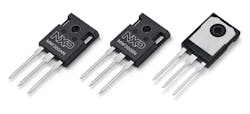Download this article in PDF format.
High-power RF transistors are usually protected by fairly costly ceramic packages, to protect the semiconductor chips inside as much from the environment as from thermal buildup. However, several high-power RF transistors from NXP Semiconductors include a 100-W device in a
TO-220 housing and a 300-W device in a TO-247 housing, with both packages being standard plastic housings, for handling ease and simplicity (Fig. 1). The transistors are supported by reference designs that demonstrate their performance from 1.8 through 250.0 MHz for applications from HF through VHF.
1. This collage of different mounting examples shows the flexibility of having the MRF101AN and MRF300AN supplied in standard, plastic packages.
The power transistors are based on laterally diffused metal-oxide-semiconductor (LDMOS) device technology, which is backed in production by well-established assembly procedures. In contrast to most standard plastic packages used for high-power RF transistors, which must be attached to a printed-circuit board (PCB) by means of a precise solder reflow process, these plastic-packaged power transistors can be added to a PCB without exotic or expensive techniques. They can be assembled to a PCB using standard through-hole technology to reduce cost. The use of standard packaging enables vertical mounting on a circuit, which helps usher in new and creative ways to achieve proper heatsinking.
The two power transistors are well-suited for commercial communications, broadcast, and industrial-scientific-medical (ISM) band applications. They are the models MRF101AN, which provides 100 W output power from a plastic TO-220 package, and MRF300AN, which delivers 300 W output power from a plastic TO-247 package. In fact, the MRF300AN has been tested as part of a reference circuit design to provide 330 W CW output power at 40.68 MHz, with 28-dB gain and 79% efficiency (Fig. 2). It’s designed to withstand impedance mismatches as severe as the equivalent of a 65.0:1 VSWR.
2. The high-power MRF300AN LDMOS transistor delivers more than 300 W pulsed or CW output power at ISM-band frequencies with high gain.
Compact 2- × 3-in. (5.1 × 7.1 cm) power block reference designs based on low-cost PCB material are available to demonstrate the capabilities of the plastic-packaged LDMOS transistors at standard application frequencies, such as 27, 40.68, 81.36, and 230 MHz. For example, by changing some coils and discrete components and without changing the PCB layout, the 40.68-MHz layout can be modified for frequencies from 1.8 to 250.0 MHz to enable quick design cycles for high-frequency circuits, such as power amplifiers. With their mounting flexibility in such plastic packages, these transistors are expected to open some new markets, e.g., high-frequency switching power supplies.
The transistors are available in a choice of plastic-packaged configurations. For example, the MRF101BN has the reverse pin-out pattern as the MRF101AN to enable easy push-pull power layouts with the two packaged transistors. The devices are part of NXP’s Product Longevity Program which guarantees availability for 15 years.
“RF power is moving increasingly into new applications, where the requirements for ease of use, high performance, and versatility are essential,” says Pierre Piel, senior director and general manager for multiple-market RF power at NXP. “We continue our mission to ease the use of RF power by delivering solutions that minimize design requirements, reduce time to market, and simplify the supply chain for our customers.”
NXP Semiconductors, High Tech Campus 60, 5656 AG Eindhoven, The Netherlands.
About the Author
Jack Browne
Technical Contributor
Jack Browne, Technical Contributor, has worked in technical publishing for over 30 years. He managed the content and production of three technical journals while at the American Institute of Physics, including Medical Physics and the Journal of Vacuum Science & Technology. He has been a Publisher and Editor for Penton Media, started the firm’s Wireless Symposium & Exhibition trade show in 1993, and currently serves as Technical Contributor for that company's Microwaves & RF magazine. Browne, who holds a BS in Mathematics from City College of New York and BA degrees in English and Philosophy from Fordham University, is a member of the IEEE.



